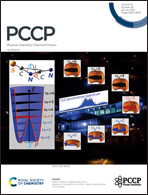First-principles based Monte Carlo modeling of the magnetization of oxygen-deficient Fe-substituted SrTiO3
Abstract
Transition-metal (TM) substituted SrTiO3 has attracted much attention because its magnetism and/or ferroelectricity can be tuned via cation substitution, point defects, strain and/or oxygen deficiency. For example, Goto et al. [Phys. Rev. Applied, 7, 024006 (2017)] reported the magnetization of SrTi1−xFexO3−δ (STF) grown under different oxygen pressures and on various substrates. Here, we use hybrid density functional theory to calculate the effects of different oxygen vacancy (VO) states in STF on the magnetization for a variety of Fe cation arrangements. The magnetic states of the cations associated with the VO ground-states for x = {0.125, 0.25} are used within a Monte Carlo model for collinear magnetism to simulate the spontaneous magnetization. Our model captures several experimental features of STF, i.e., an increase in magnetization for small δ up to a maximum of ∼0.35μB per formula unit at an intermediate number of vacancies, with a slower decrease in magnetization with an increasing number of vacancies. Our approach gives insight into the relation between vacancy concentration and the oxygen pressure required to maximize the magnetization.



 Please wait while we load your content...
Please wait while we load your content...